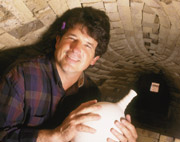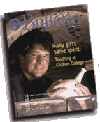
Merrill Krabillassociate professor of art, 2001-presentBy Rachel LappAssociate Professor of Art Merrill Krabill sees an unformed piece of clay, unexposed film or a blank canvas as a question for him or his students: What am I going to do? To help them answer that query, Krabill finds it important to demonstrate his own thinking and work “as part of who you are as a teacher. You put who you are into a piece in many ways,” said Krabill. “I try to tell, and to show students, to use their own experiences to generate their work – not to give them parameters or exact directions, but to allow them to explore different ways of thinking and creating.” Krabill encourages students to look at work from different perspectives in order to see how one project – or one life decision, for that matter – might lead to the next. “Patterns and directions do emerge,” said Krabill. “There are differences between something linear and something three-dimensional, more multifaceted. We need both to understand the world around us.” Discovering and developing interest in multiple mediums has been part of Krabill’s art education after college as well. He found himself on a path that put him in touch with internationally known visual artist Paul Soldner, who works in clay, bronze, prints and photography. Soldner, himself the son of a Mennonite minister, became a mentor to Krabill teaching him to “learn by watching. At Goshen, that is deeply engrained as part of who you are as a teacher.” Soldner encouraged Krabill to enter the ceramics program at Claremont Graduate University, where he earned his master’s degree in fine arts. Krabill has used various mediums to explore his experiences and to teach art students. During the 2001-02 academic year, his course load included Ceramics, Creating for the Web, Basic Design and two photography courses. Said Krabill, “Those types of combinations aren’t unfamiliar; I covered even more media areas at Bethel College,” his previous teaching post. “You try to be honest – let students know what you know, which is healthy pedagogy – and show them you are serious about the field and teaching through your explorations with them.” At the same time, students come with “a range of experience and expectation” for art classes. “I am comfortable with that – whether a student is interested in making a mug or taking better photos or creating modern art,” said Krabill. That range, for Krabill, typifies the balance he appreciates within liberal arts education, which encourages students to become well-rounded and create from their talents that span a wealth of subjects, concepts and beliefs. “I like the liberal arts, I believe in the product; I feel much more vested in the kind of education students are receiving here. The campus is integrated, not islands of isolated fields,” said Krabill. “And the integration of the spiritual and vocational just makes a lot of sense to me. It changes the way relationships happen – not that we can’t always make them better, but there is an understanding that this is a Christian community that provides a rich context for understanding the interconnectedness of other areas and other people.” In his first professorial exhibit in the college’s art gallery, Krabill focused on connections within his own family through their journey with daughter Emily, who has Down’s Syndrome. The show prompted students to ask questions about whether the work took advantage of Emily, and wonder about his references to Job when describing times of challenge for his family. “I took a risk in the paired photos in showing the negative parts or struggles of what has largely been a positive experience. Emily is a blessing. I think you need to see both perspectives in order to understand the world.” |
| Top of page |


